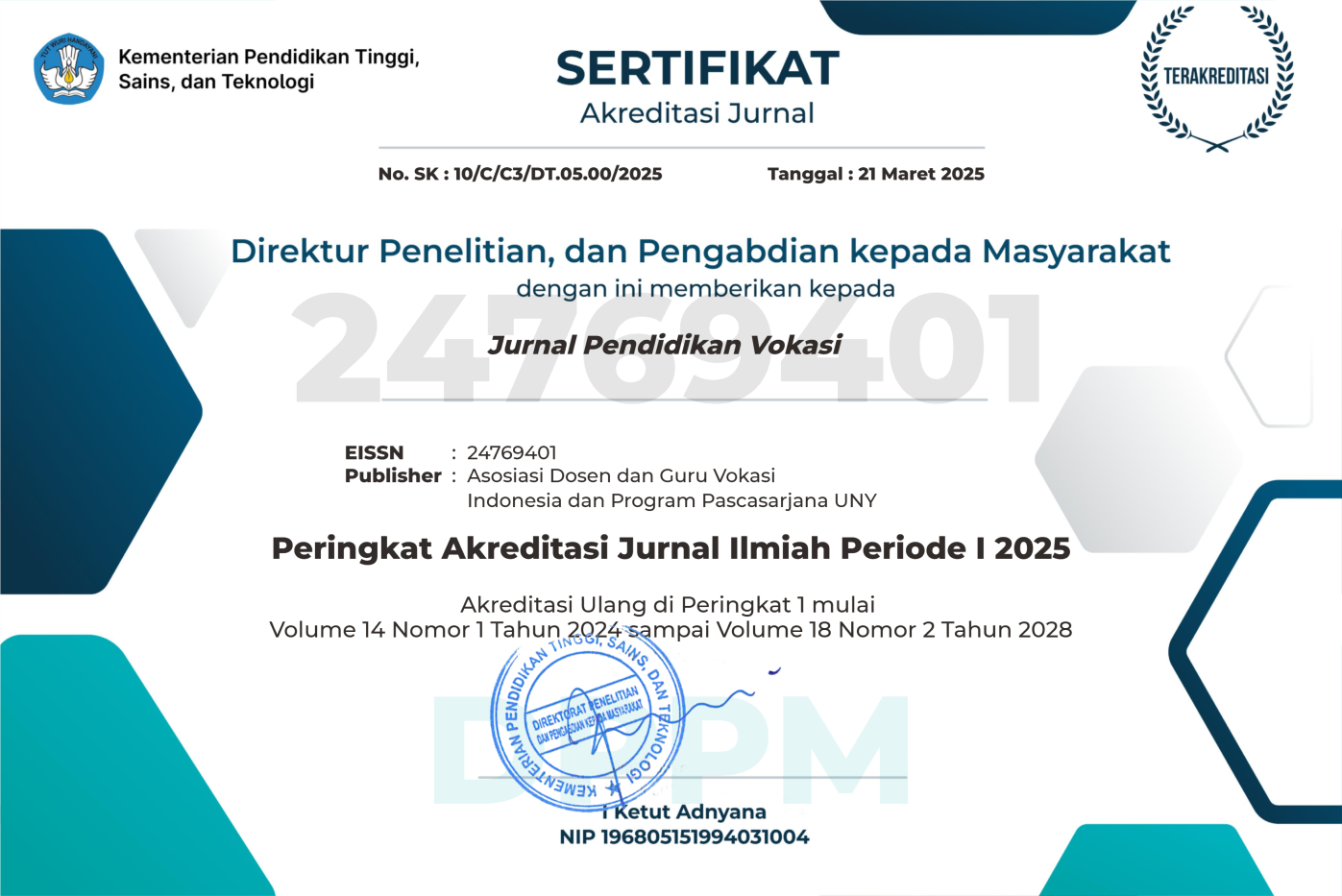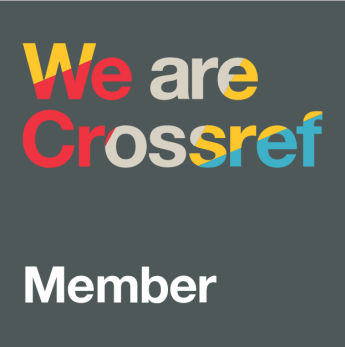Curriculum and learning management: Integration of creative economy value to improve students' life skill
DOI:
https://doi.org/10.21831/jpv.v12i1.44253Keywords:
Creative economy value, curriculum development, integration of learning, vocational high schoolAbstract
References
Akaninwor, G. I. K. (2001). Toward Effective Curriculum Development in Vocational/Technical Education for Sustainable Poverty Alleviation in Nigeria. In Research Gate (Issue January 2001).
Albashiry, N. M., Voogt, J. M., & Pieters, J. M. (2015). Improving curriculum development practices in a technical vocational community college: examining effects of a professional development arrangement for middle managers. Curriculum Journal, 26(3), 425–451. https://doi.org/10.1080/09585176.2015.1040041
Badan Pusat Statistik Republik Indonesia. (2020). Februari 2020: Tingkat Pengangguran Terbuka (TPT) sebesar 4,99 persen. In bps.go.id. Badan Pusat Statistik Indonesia. https://www.bps.go.id/pressrelease/2020/05/05/1672/februari-2020--tingkat-pengangguran-terbuka--tpt--sebesar-4-99-persen.html
Brinkerhoff, D. A. (2001). Survey of instructional development models, third edition. TechTrends, 45(1), 48–50. https://doi.org/10.1007/BF02763388
Comunian, R., Faggian, A., & Jewell, S. (2015). Digital technology and creative arts career patterns in the UK creative economy. Journal of Education and Work, 28(4), 346–368. https://doi.org/10.1080/13639080.2014.997683
Cummins, A. M., Smith, R., Catling, C., Watts, N., Scarf, V., Fox, D., & Gray, J. (2018). Midwifery Graduate Attributes: A model for curriculum development and education. Midwifery, 61, 66–69. https://doi.org/10.1016/J.MIDW.2018.02.019
D'Andrea, M. (2012). The ontario curriculum in the arts and the creative economy agenda. Arts Education Policy Review, 113(2), 80–88. https://doi.org/10.1080/10632913.2012.656499
Garbin, A. P., & Stover, R. G. (1980). Vocational behavior and career development, 1979: A review. Journal of Vocational Behavior, 17(2), 125–170. https://doi.org/10.1016/0001-8791(80)90001-9
Howkins, J. (2001). The creative economy : How people make money from ideas. Penguin Press.
Malaikosa, Y. M. L., Ulfatin, N., Degeng, N. S., & Maisyaroh, M. (2020). Curriculum management and learning with creative economics to shape life skills. International Journal of Innovation, Creativity and Change, 12(12), 444–456. https://www.ijicc.net/images/vol12/iss12/121239_Malaikosa_2020_E_R.pdf
Masunah, J. (2017). Creative industry: Two cases of performing arts market in Indonesia and South Korea. Humaniora, 29(1), 108–118. https://doi.org/10.22146/jh.22572
Miles, M. B., Huberman, A. M., & Saldana, J. (2019). Qualitative data analysis: A methods sourcebook (4th ed.). SAGE Publications, Inc.
Moleong, L. J. (2014). Metodologi penelitian kualitatif (edisi revisi). Remaja Rosdakarya.
Munastiwi, E. (2015). The management model of vocational education quality assurance using "˜Holistic Skills Education (Holsked).' Procedia - Social and Behavioral Sciences, 204, 218–230. https://doi.org/10.1016/j.sbspro.2015.08.144
Munro, E. (2017). Poetics Building soft skills in the creative economy: Creative intermediaries, business support and the "˜soft skills gap". Poetics, 64, 14–25. https://doi.org/10.1016/j.poetic.2017.07.002
Pane, M. M., & Patriana, R. (2016). The significance of environmental contents in character education for quality of life. Procedia - Social and Behavioral Sciences, 222, 244–252. https://doi.org/10.1016/j.sbspro.2016.05.153
Pratt, A. C., & Hutton, T. A. (2013). Reconceptualising the relationship between the creative economy and the city: Learning from the financial crisis q. Cities, 33, 86–95. https://doi.org/10.1016/j.cities.2012.05.008
Raffe, D. (1991). Assessing the impact of a decentralised initiative: The British technical and vocational education initiative. In S. W. Raudenbush & J. D. Willms (Eds.), Schools, Classrooms, and Pupils (pp. 149–166). Academic Press. https://doi.org/10.1016/B978-0-12-582910-6.50016-2
Rahadian, L. (2019, March 16). Skill tak sesuai, suplai tenaga kerja tak terserap. Ekonomi.Bisnis.Com. https://ekonomi.bisnis.com/read/20190316/12/900380/skill-tak-sesuai-suplai-tenaga-kerja-tak-terserap
Ratnasari, E. D. (2018, February 26). BPS: Lulusan SMK banyak menganggur sepanjang 2017. CNN Indonesia. https://www.cnnindonesia.com/gaya-hidup/20180223141505-282-278333/bps-lulusan-smk-banyak-menganggur-sepanjang-2017
Rokhman, F., Hum, M., Syaifudin, A., & Yuliati Yuliati. (2014). Character education for golden generation 2045 (national character building for indonesian golden years). Procedia - Social and Behavioral Sciences, 141, 1161–1165. https://doi.org/10.1016/j.sbspro.2014.05.197
Schlesinger, P., Selfe, M., & Munro, E. (2015). Inside a cultural agency: Team ethnography and knowledge exchange. Journal of Arts Management Law and Society, 45(2), 66–83. https://doi.org/10.1080/10632921.2015.1039741
Sugiyono, S. (2013). Metode penelitian pendidikan: Pendekatan kuantitatif, kualitatif, dan R & D (17th ed.). Alfabeta.
Sung, T. K. (2015). The creative economy in global competition. Technological Forecasting and Social Change, 96, 89–91. https://doi.org/10.1016/j.techfore.2015.04.003
Tronsmo, E., & Nerland, M. (2018). Local curriculum development as object construction: A sociomaterial analysis. Teaching and Teacher Education, 72, 33–43. https://doi.org/10.1016/j.tate.2018.02.008
Ulfatin, N. (2015). Metode penelitian kualitatif di bidang pendidikan: Teori dan aplikasinya. Media Nusa Creative.
Ulfatin, N. (2016). Pengembangan kurikulum belajar dan berkarya. UM Press.
Widyadharma, A. P., Ulfatin, N., Utaya, S., & Supriyanto, A. (2020). Situational leadership with the STIFIn genetic intelligence approach. Systematic Reviews in Pharmacy, 11(6), 1409–1419. https://doi.org/10.31838/srp.2020.6.202
Wu, Y.-L., & Jia-Jen-Hu, J.-J.-H. (2015). Skill learning attitudes, satisfaction of curriculum, and vocational self-concept among junior high school students of technical education programs. Procedia - Social and Behavioral Sciences, 174, 2862–2866. https://doi.org/10.1016/j.sbspro.2015.01.980
Yuan, Y.-H., Wu, M.-H., & Lee, J.-C. (2014). The essential difference on public or private vocational school – the student's creativity of mechanical engineering. Procedia - Social and Behavioral Sciences, 116, 2321–2329. https://doi.org/10.1016/j.sbspro.2014.01.567
Downloads
Published
How to Cite
Issue
Section
Citation Check
License
The authors submitting a manuscript to this journal agree that, if accepted for publication, copyright publishing of the submission shall be assigned to Jurnal Pendidikan Vokasi. However, even though the journal asks for a copyright transfer, the authors retain (or are granted back) significant scholarly rights.
The copyright transfer agreement form can be downloaded here: [JPV Copyright Transfer Agreement Form]
The copyright form should be signed originally and sent to the Editorial Office through email to jpvokasi@uny.ac.id
Jurnal Pendidikan Vokasi by http://journal.uny.ac.id/index.php/jpv is licensed under a Creative Commons Attribution-ShareAlike 4.0 International License.














